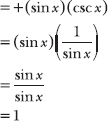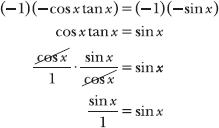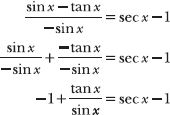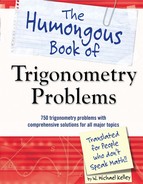What happens when you plug in –x?
7.13 Evaluate each of the six trigonometric functions for –x to generate the negative trigonometric identities.
Consider the graphs of the trigonometric functions that you generate in Chapters 5 and 6. Any graph that is symmetric about the y-axis—in other words, the graph is a reflection of itself across the y-axis, as though that vertical line were a mirror—is described as an “even function.” If f(x) is an even function, then f(–x) = f(x). You get the same output when a real number and its opposite are substituted into the function.
Of the six trigonometric functions, only two have y-symmetric graphs and are, therefore, even functions: cos x and its reciprocal sec x. Therefore, cos (–x) = cos x and sec (–x) = sec x. The other four trigonometric functions are origin-symmetric, and are considered “odd functions.” If g(x) is an odd function, then g(–x) = –g(x). Hence, substituting x and –x into an odd function produce opposite results: sin(–x) = –sin x, tan (–x) = –tan x, csc (–x) = –csc x, and cot (–x) = –cot x.
Odd functions do exactly opposite things on either side of the origin. Think of the graph of tangent as an example. Immediately to the right of the origin, the graph shoots up and to the right, but to the left of the origin, the graph shoots down and to the left.
7.14 Simplify the expression: sin (–x) csc (–x).
Both sine and cosecant are odd functions, as explained in Problem 7.13, so sin (–x) = –sin x and csc (–x) = –csc x.
sin (–x) csc (–x) = (–sin x)(–csc x)
Apply a reciprocal identity to simplify the expression, and note that the product of two negative values is positive.

7.15 Write the expression as a single fraction: 3sec (–θ) + 2.
Secant is an even function, so sec (–θ) = sec θ. Apply a reciprocal identity to express the first term as a fraction.

In order to add the terms, they must share a common denominator, so multiply the numerator and denominator of the second term by cos θ.
7.16 Verify the statement: ![]() .
.
Whereas the preceding problems in this chapter ask you to simplify an expression, this problem directs you to verify a statement—an equation. In order to prove the statement true, you will manipulate one or both sides of the equation until it is absolutely clear that both sides of the equation are equal.
In this problem, you should manipulate the right side of the equation, applying the negative identity cos (–x) = cos x.

Because tangent is defined as the quotient of sine and cosine, tan x = sin x/cos x. is an obviously true statement, so you have successfully verified the original statement.
7.17 Verify the statement: ![]() .
.
In order to verify this statement, you will simplify each side of the equation individually. Begin by applying the negative identities cos (–x) = cos x and tan (–x) = –tan x to the left side of the equation.

Now apply a cofunction identity to the right side of the equation.
–cos x tan x = –(sin x)
The statement is not yet obviously true. Multiply both sides by –1 and express tan x in terms of sine and cosine.
Expressing everything in terms of sine and cosine is a very useful trick for verifying trig statements. Remember it.

The final equation (sin x = sin x) is an obviously true statement that is logically equivalent to the initial equation. Because the final statement is true, you can conclude that the first statement is true as well.

7.18 Simplify the expression: ![]() .
.
Although it may appear so at first glance, cot (θ – π/2) is not a cofunction identity, because the argument of the trigonometric expression is θ – π/2, not π/2 – θ. In order to apply the cofunction identity, you must factor –1 out of the terms in order to reverse them, as demonstrated below. Notice that the –1 that is factored out of the expression still appears within the argument of cotangent.
“Argument” means “the thing you plug into the function.” In other words, the argument of sin x is x.
![]()
According to the negative identities, cot (–x) = –cot x.
In other words, that –1 you just factored out of the input can now be pulled out of the input and placed in front of the function.
![]()
Apply cofunction identities and express the functions in terms of sine and cosine.

7.19 Verify the statement: ![]() .
.
Apply negative identities to simplify the left side of the equation, and then express the functions in terms of sine and cosine.

Now that you have fully simplified the left side of the equation, simplify the right side. Notice that dividing by sec x is the same as multiplying by its reciprocal, cos x.

Remember, once you get an obviously true equation, you’ve verified the original statement.

Both cosine and secant are even functions, so according to the negative identities, cos (–x) = cos x and sec (–x) = sec x. Note that adding fractions requires common denominators, so you must multiply the numerator and denominator of the first fraction by sec x + 1 and multiply the numerator and denominator of the second fraction by cos x + 1.

Multiply the factors in the denominator using the FOIL method. Note that (sec x)(cos x) = 1 because secant and cosine are reciprocal functions.

Any value divided by itself, even something big like (sec x + cos x + 2), is equal to 1.
7.21 Write the fraction as a sum or difference of two terms: ![]() .
.
Note that this problem simply asks you to simplify a single expression, not to verify an equation (like Problems 7.19 and 7.20). To begin, apply a negative identity to express sin (–x) as –sin x.
![]()
If a fraction contains two or more terms in the numerator and only one term in the denominator, then you can rewrite that fraction as the sum or difference of the individual numerator terms, each divided by the common denominator.

For example,  .
.
Begin by applying negative identities to rewrite sin (–x) and sec (–x), and then use the technique demonstrated in Problem 7.21 to express the single fraction on the left side of the equation as two fractions with a common denominator.

If you add 1 to both sides of the equation, and apply a reciprocal identity to rewrite sec x as 1/cos x, the result is a proportion.

Cross-multiply to eliminate the fractions from the equation and simplify.


